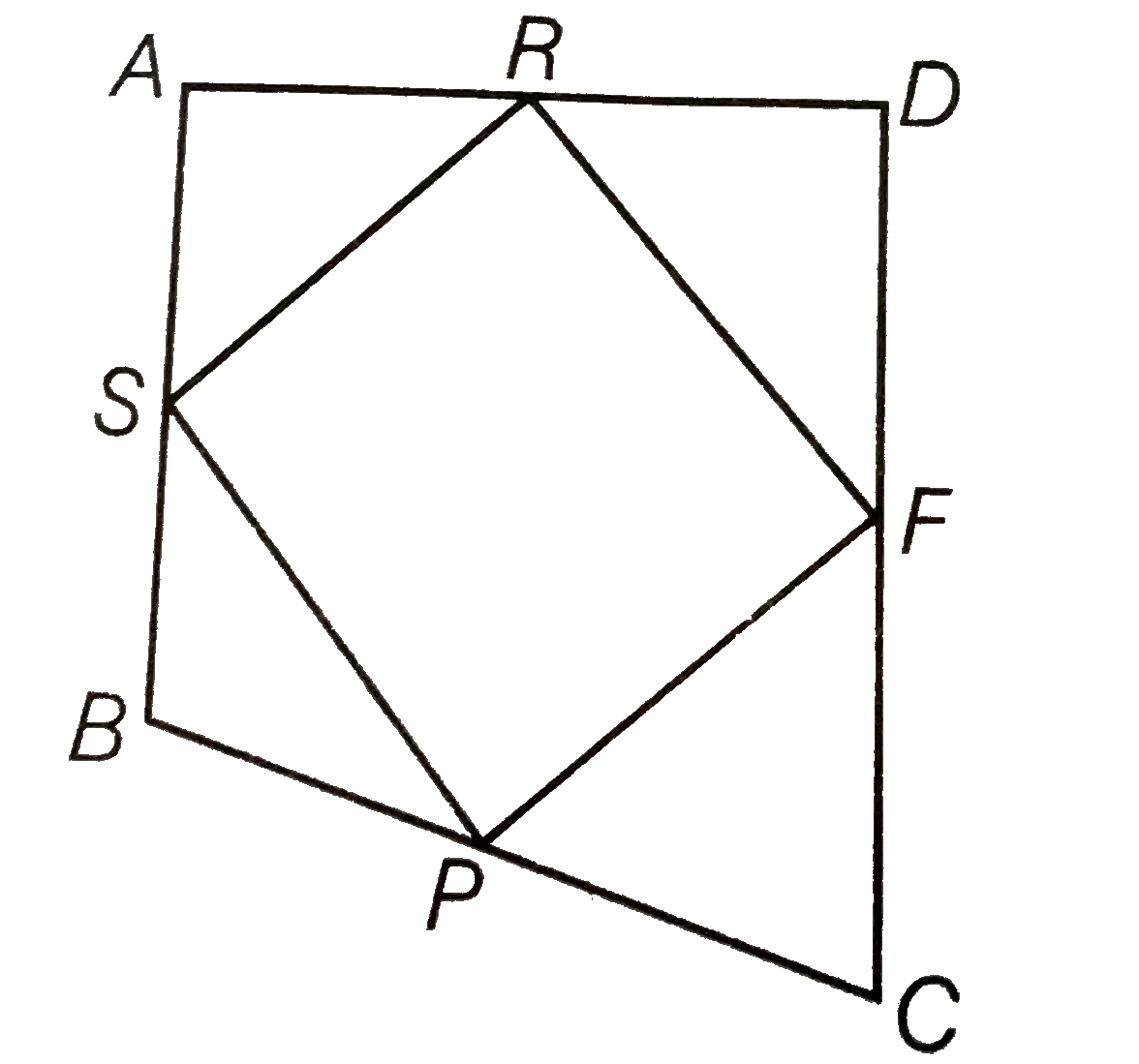If the opposite sides of a quadrilateral are equal, prove that the quadrilateral is a parallelogram.
To prove that a quadrilateral is a parallelogram when its opposite sides are equal, we can follow these steps:
1. Given Information:
- Let quadrilateral ABCD be such that:
- AB=CD (opposite sides are equal)
- AD=BC (opposite sides are equal)
2. Draw Diagonal:
- Draw diagonal AC in quadrilateral ABCD.
3. Consider Triangles:
- Now, consider triangles △ABC and △CDA.
4. Identify Sides:
- From the given information, we have:
- AB=CD (1)
- AD=BC (2)
- AC=AC (common side)
5. Apply the Side-Side-Side (SSS) Congruence Criterion:
- Since we have:
- AB=CD (from 1)
- AD=BC (from 2)
- AC=AC (common side)
- By the SSS criterion, we can conclude that:
- △ABC≅△CDA
6. Corresponding Angles:
- From the congruence of triangles, we can say:
- ∠CAB=∠ACD (corresponding angles)
- ∠ABC=∠CDA (corresponding angles)
7. Identify Alternate Angles:
- Since AC is a transversal line for the two lines AB and CD:
- ∠CAB=∠ACD are alternate angles.
- ∠ABC=∠CDA are also alternate angles.
8. Conclude Parallel Lines:
- Since ∠CAB=∠ACD and ∠ABC=∠CDA, we can conclude:
- AB∥CD (because of alternate angles)
- AD∥BC (because of alternate angles)
9. Final Conclusion:
- Since both pairs of opposite sides are equal and parallel, we can conclude that quadrilateral ABCD is a parallelogram.
Final Statement:
Thus, we have proved that if the opposite sides of a quadrilateral are equal, then the quadrilateral is a parallelogram.
---
- Let quadrilateral ABCD be such that:
- AB=CD (opposite sides are equal)
- AD=BC (opposite sides are equal)
- Draw diagonal AC in quadrilateral ABCD.
- Now, consider triangles △ABC and △CDA.
- From the given information, we have:
- AB=CD (1)
- AD=BC (2)
- AC=AC (common side)
- Since we have:
- AB=CD (from 1)
- AD=BC (from 2)
- AC=AC (common side)
- By the SSS criterion, we can conclude that:
- △ABC≅△CDA
- From the congruence of triangles, we can say:
- ∠CAB=∠ACD (corresponding angles)
- ∠ABC=∠CDA (corresponding angles)
- Since AC is a transversal line for the two lines AB and CD:
- ∠CAB=∠ACD are alternate angles.
- ∠ABC=∠CDA are also alternate angles.
- Since ∠CAB=∠ACD and ∠ABC=∠CDA, we can conclude:
- AB∥CD (because of alternate angles)
- AD∥BC (because of alternate angles)
- Since both pairs of opposite sides are equal and parallel, we can conclude that quadrilateral ABCD is a parallelogram.
Thus, we have proved that if the opposite sides of a quadrilateral are equal, then the quadrilateral is a parallelogram.
Topper's Solved these Questions
- CONGRUENCE OF TRIANGLES BOOK - MTG IIT JEE FOUNDATIONCHAPTER - CONGRUENCE OF TRIANGLES EXERCISE - NCERT Section (Exercise 7.1)
9 Videos
- CONGRUENCE OF TRIANGLES BOOK - MTG IIT JEE FOUNDATIONCHAPTER - CONGRUENCE OF TRIANGLES EXERCISE - NCERT Section (Exercise 7.2)
20 Videos
- CONGRUENCE OF TRIANGLES BOOK - MTG IIT JEE FOUNDATIONCHAPTER - CONGRUENCE OF TRIANGLES EXERCISE - Olympiad/HOTS Corner
10 Videos
- COMPARING QUANTITIES BOOK - MTG IIT JEE FOUNDATIONCHAPTER - COMPARING QUANTITIES EXERCISE - Olympaid/HOTS Corner
20 Videos
- DATA HANDLINGBOOK - MTG IIT JEE FOUNDATIONCHAPTER - DATA HANDLINGEXERCISE - Olympiad / Hots Corner
20 Videos
Similar Questions
Theorem 8.3 : If each pair of opposite sides of a quadrilateral is equal, then it is a parallelogram.
View SolutionIf two sides of a cyclic quadrilateral are equal, prove that the other two sides are parallel.
View SolutionIf the diagonals of a quadrilateral bisect each other, then the quadrilateral is a parallelogram.
View SolutionIf two opposite sides of a cyclic quadrilateral are equal, then the other two sides are parallel.
View SolutionIf the diagonals of a quadrilateral bisect each other, then the quadrilateral is a parallelogram.
View SolutionIf the two sides of a pair of opposite sides of a cyclic quadrilateral are equal, prove that its diagonals are equal.
View SolutionIf two opposite sides of a cyclic quadrilateral are equal; then the other two sides are parallel.
View SolutionIf the mid-points of the sides of a quadrilateral are joined in order, prove that the area of the parallelogram, so formed will be half of the area of the given quadrilateral (figure).

View SolutionThe opposite sides of a quadrilateral are parallel. If one angle of the quadrilateral is 60∘, find the other angles.
View SolutionThe converse of the above properties are also true i.e.(i) A quadrilateral is a parallelogram if its opposite sides are equal.(ii)A quadrilateral is a parallelogram if its opposite angles are equal.(iii) A quadrilateral is a parallelogram if it has one pair of opposite sides parallel and equal.(iv) A quadrilateral is a parallelogram if its diagonals bisect each other .
View Solution
